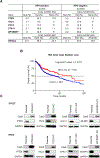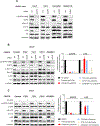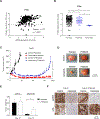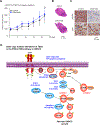Pathway-Specific Genome Editing of PI3K/mTOR Tumor Suppressor Genes Reveals that PTEN Loss Contributes to Cetuximab Resistance in Head and Neck Cancer
- PMID: 32430488
- PMCID: PMC7357849
- DOI: 10.1158/1535-7163.MCT-19-1036
Pathway-Specific Genome Editing of PI3K/mTOR Tumor Suppressor Genes Reveals that PTEN Loss Contributes to Cetuximab Resistance in Head and Neck Cancer
Abstract
Cetuximab, an mAb targeting EGFR, is a standard of care for the treatment for locally advanced or metastatic head and neck squamous cell carcinoma (HNSCC). However, despite overexpression of EGFR in more than 90% of HNSCC lesions, most patients with HNSCC fail to respond to cetuximab treatment. In addition, there are no available biomarkers to predict sensitivity or resistance to cetuximab in the clinic. Here, we sought to advance precision medicine approaches for HNSCC by identifying PI3K/mTOR signaling network-specific cetuximab resistance mechanisms. We first analyzed the frequency of genomic alterations in genes involved in the PI3K/mTOR signaling circuitry in the HNSCC TCGA dataset. Experimentally, we took advantage of CRISPR/Cas9 genome editing approaches to systematically explore the contribution of genomic alterations in each tumor suppressor gene (TSG) controlling the PI3K-mTOR pathway to cetuximab resistance in HNSCC cases that do not exhibit PIK3CA mutations. Remarkably, we found that many HNSCC cases exhibit pathway-specific gene copy number loss of multiple TSGs that normally restrain PI3K/mTOR signaling. Among them, we found that both engineered and endogenous PTEN gene deletions can mediate resistance to cetuximab. Our findings suggest that PTEN gene copy number loss, which is highly prevalent in HNSCC, may result in sustained PI3K/mTOR signaling independent of EGFR, thereby representing a promising mechanistic biomarker predictive of cetuximab resistance in this cancer type. Further prospective studies are needed to investigate the impact of PTEN loss on cetuximab efficacy in the clinic.
©2020 American Association for Cancer Research.
Conflict of interest statement
Figures





Similar articles
-
mTOR co-targeting in cetuximab resistance in head and neck cancers harboring PIK3CA and RAS mutations.J Natl Cancer Inst. 2014 Aug 5;106(9):dju215. doi: 10.1093/jnci/dju215. Print 2014 Sep. J Natl Cancer Inst. 2014. PMID: 25099740 Free PMC article.
-
Biomarkers of cetuximab resistance in patients with head and neck squamous cell carcinoma.Cancer Biol Med. 2020 Feb 15;17(1):208-217. doi: 10.20892/j.issn.2095-3941.2019.0153. Cancer Biol Med. 2020. PMID: 32296588 Free PMC article.
-
Upregulation of secreted phosphoprotein 1 affects malignant progression, prognosis, and resistance to cetuximab via the KRAS/MEK pathway in head and neck cancer.Mol Carcinog. 2020 Oct;59(10):1147-1158. doi: 10.1002/mc.23245. Epub 2020 Aug 17. Mol Carcinog. 2020. PMID: 32805066
-
PI3K/AKT/mTOR signaling as a molecular target in head and neck cancer.Biochem Pharmacol. 2020 Feb;172:113729. doi: 10.1016/j.bcp.2019.113729. Epub 2019 Nov 27. Biochem Pharmacol. 2020. PMID: 31785230 Review.
-
The PI3K/Akt/mTORC signaling axis in head and neck squamous cell carcinoma: Possibilities for therapeutic interventions either as single agents or in combination with conventional therapies.IUBMB Life. 2021 Apr;73(4):618-642. doi: 10.1002/iub.2446. Epub 2021 Feb 4. IUBMB Life. 2021. PMID: 33476088 Review.
Cited by
-
Application of single-cell RNA sequencing in head and neck squamous cell carcinoma.Chin J Cancer Res. 2023 Aug 30;35(4):331-342. doi: 10.21147/j.issn.1000-9604.2023.04.01. Chin J Cancer Res. 2023. PMID: 37691894 Free PMC article.
-
HPV-driven cancers: a looming threat and the potential of CRISPR/Cas9 for targeted therapy.Virol J. 2025 May 22;22(1):156. doi: 10.1186/s12985-025-02783-x. Virol J. 2025. PMID: 40400023 Free PMC article. Review.
-
Comprehensive review of CRISPR-based gene editing: mechanisms, challenges, and applications in cancer therapy.Mol Cancer. 2024 Jan 9;23(1):9. doi: 10.1186/s12943-023-01925-5. Mol Cancer. 2024. PMID: 38195537 Free PMC article. Review.
-
Inhibition of mTOR signaling and clinical activity of metformin in oral premalignant lesions.JCI Insight. 2021 Sep 8;6(17):e147096. doi: 10.1172/jci.insight.147096. JCI Insight. 2021. PMID: 34255745 Free PMC article. Clinical Trial.
-
Epidermal growth factor receptor signaling in precancerous keratinocytes promotes neighboring head and neck cancer squamous cell carcinoma cancer stem cell-like properties and phosphoinositide 3-kinase inhibitor insensitivity.Mol Carcinog. 2022 Jul;61(7):664-676. doi: 10.1002/mc.23409. Epub 2022 Apr 13. Mol Carcinog. 2022. PMID: 35417043 Free PMC article.
References
-
- Siegel RL, Miller KD, Jemal A. Cancer statistics, 2019. CA Cancer J Clin [Internet]. 2019;69:7–34. Available from: http://www.ncbi.nlm.nih.gov/pubmed/30620402 - PubMed
Publication types
MeSH terms
Substances
Grants and funding
LinkOut - more resources
Full Text Sources
Other Literature Sources
Medical
Research Materials
Miscellaneous

